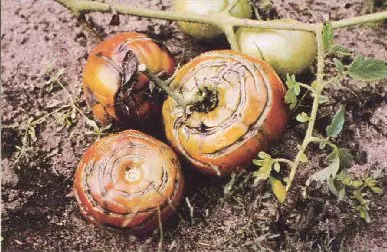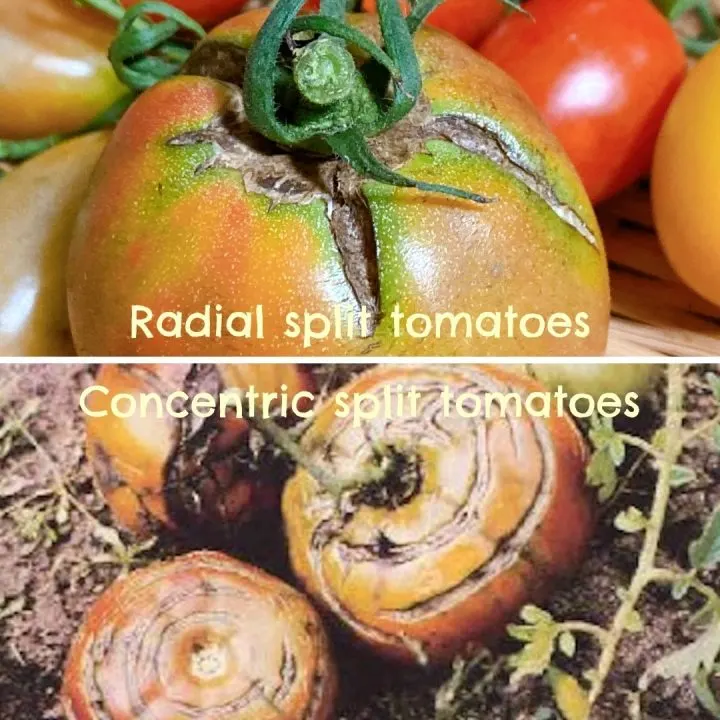In mid-summer, our backyard garden looks pretty wild. Guessing you can relate? It’s also a time of year that our tomatoes can end up looking less than perfect, especially the cracks. But what causes split tomatoes in the garden?
But we’re getting ahead of ourselves. First, let’s discuss what causes split tomatoes in the garden, and then we can get to the remedies.
What’s that old drought joke…?
“It was so dry we saw two trees fighting over a dog.” 🤣
What Causes Split Tomatoes in the Garden?
The primary cause of cracked and split tomatoes is inconsistent watering, especially the contrast of summer drought followed by lots of rain. This mostly affects the more ripe tomatoes… you know, those beauties that cause your mouth to water as you walk by and that you’re planning on harvesting soon.
Tomatoes have a high water content, and when it rains, especially after drought conditions, the fruit rapidly soak up the water, which causes the fruit to expand.
The mature tomato skin is thinner and less resilient, so as the tomato expands faster than the tomato skin can stretch the result is cracked and split skin. It’s kind of like stretch marks, where the skin can’t keep pace with the rate of expansion of the body of the fruit.
Tomatoes expand with water from rain or watering following a drought and the fragile maturing tomato skin becomes more tightly stretched and splits.
Two Types of Tomato Splits
- Radial Cracking – are vertical splits along the sides of fruits that typically occur during hot, humid weather.
- Concentric Cracking – occurs in a circular pattern at the top stem end of tomatoes.
It’s About More Than Looks
If it were just a matter of aesthetics, it wouldn’t matter so much. Sure… we like to see those perfect specimen tomatoes, however the cracks in tomatoes and other fruit can lead to other problems.
If you’re having different kinds of problems with your tomatoes, check out tomato plant diseases here.
Problems Caused by Split Tomatoes in the Garden
- Split tomatoes invites intruders like ants to access the soft interior.
- Early cracking in green tomatoes leads to rot before ripening if left on the vine.
- Fungus invades the interior through the tomato splits.
- Ants and insects move in and ruin the fruit.
As tomatoes approach maturity the skin becomes more fragile and more tightly stretched.

Preventing Tomato Splits and Cracks
With dry spells of summer comes the prospect of bad things happening to tomatoes when we do get a big rain. Our “perfect” unripe tomatoes can only handle so much water before the tomatoes split into cracks. So what to do to keep tomatoes from splitting?
How to Prevent Tomatoes from Splitting
- Water tomatoes daily (excepting rainy days), but not excessively. It’s a simple time saver to set your watering up on a timer. We have 2 drip irrigation systems with a timer set for 2x/day, at 6 a.m. and 7:15 p.m. for 40 minutes each system, (so 80 minutes total watering time in the morning and again in the evening).
- Pick tomatoes before it rains when rain is due.
- Pick tomatoes before they’re perfectly ripe. Tomatoes will continue ripening off the vine, even if picked green. Of course red tinged is best for more flavor, however, they all ripen surprisingly well.
Some gardeners pick their ripe and trending ripe tomatoes before a big rain. Others wait to see the effects and then pick the damaged ones.
It’s best not to leave split or deeply cracked tomatoes on the vines because opportunistic pests like insects and fungi can move in and make the fruits inedible. If picked early, at least you have a complete fruit that can be coaxed into ripening.
The timed drip irrigation has really helped. We had to make field adjustments on occasion, such as increasing the watering frequencies during dry spells, and turning it off during wet periods.
It’s best not to leave split or deeply cracked tomatoes on their vines.
How to Ripen Tomatoes Off the Vine
Vine ripened tomatoes in full sun are going to have the best, richest and sweetest flavor. However, you can ripen green tomatoes off the vine, and they will still taste good, but just not as stellar as the usual vine ripened homegrown tomatoes.
There are many approaches to ripening tomatoes, and here are a few, mostly anecdotal contributions from GardensAll readers on what they do that works for them.
Methods for Ripening Tomatoes
We’ve tried #1, but the others have been shared by others.
- Place on a windowsill exposed to light
- Wrap individual tomatoes in newspaper and store in a box
- Pull up entire plant and hang it upside down
- Place in paper bag with a banana peel
Staking Tomato Plants
In an earlier article, we covered pruning tomato plants and found there’s a trade-off between pruning and the quantity of tomatoes. This season, we’re pruning a few “suckers” off our tomatoes, but we’re also letting the plants go a little “wild”.
Typically we prune more. This year we’re leaving a lot more stems on to see if it produces more fruit, and so far it certainly looks that way, but results may vary. We like to experiment each year, so we’ll circle back around with updates.
To keep fruit laden branches from flopping over and breaking, we’re setting up bamboo supports wherever needed thus allowing more tomato foliage and — we expect — more tomatoes.. This array of props definitely gives an organic look to our tomato jungle.
See more here on staking tomatoes.

Heirloom Tomatoes Are Delicious but…
We lost a tomato plant to sudden wilt from the base to the tip. It’s likely the fungus, fusarium, due to the hot temps. We extracted the sick plant completely and put it on our burn pile a good stone’s throw away.
So far, the surrounding plants are okay. We really enjoy the heirloom tomatoes, but be forewarned, they don’t have the VFNT (Verticillium, Fusarium, Nematode, Tobacco mosaic) resistance found in many hybrid tomatoes.
Heirloom tomatoes are not as pest and disease resistance.
You can find more on tomato plant diseases here.

Tally hoe!
Let’s Keep on Growing!
G. Coleman Alderson is an entrepreneur, land manager, investor, gardener, and author of the novel, Mountain Whispers: Days Without Sun. Coleman holds an MS from Penn State where his thesis centered on horticulture, park planning, design, and maintenance. He’s a member of the Phi Kappa Phi Honor Society and a licensed building contractor for 27 years. “But nothing surpasses my 40 years of lessons from the field and garden. And in the garden, as in life, it’s always interesting because those lessons never end!” Coleman Alderson

